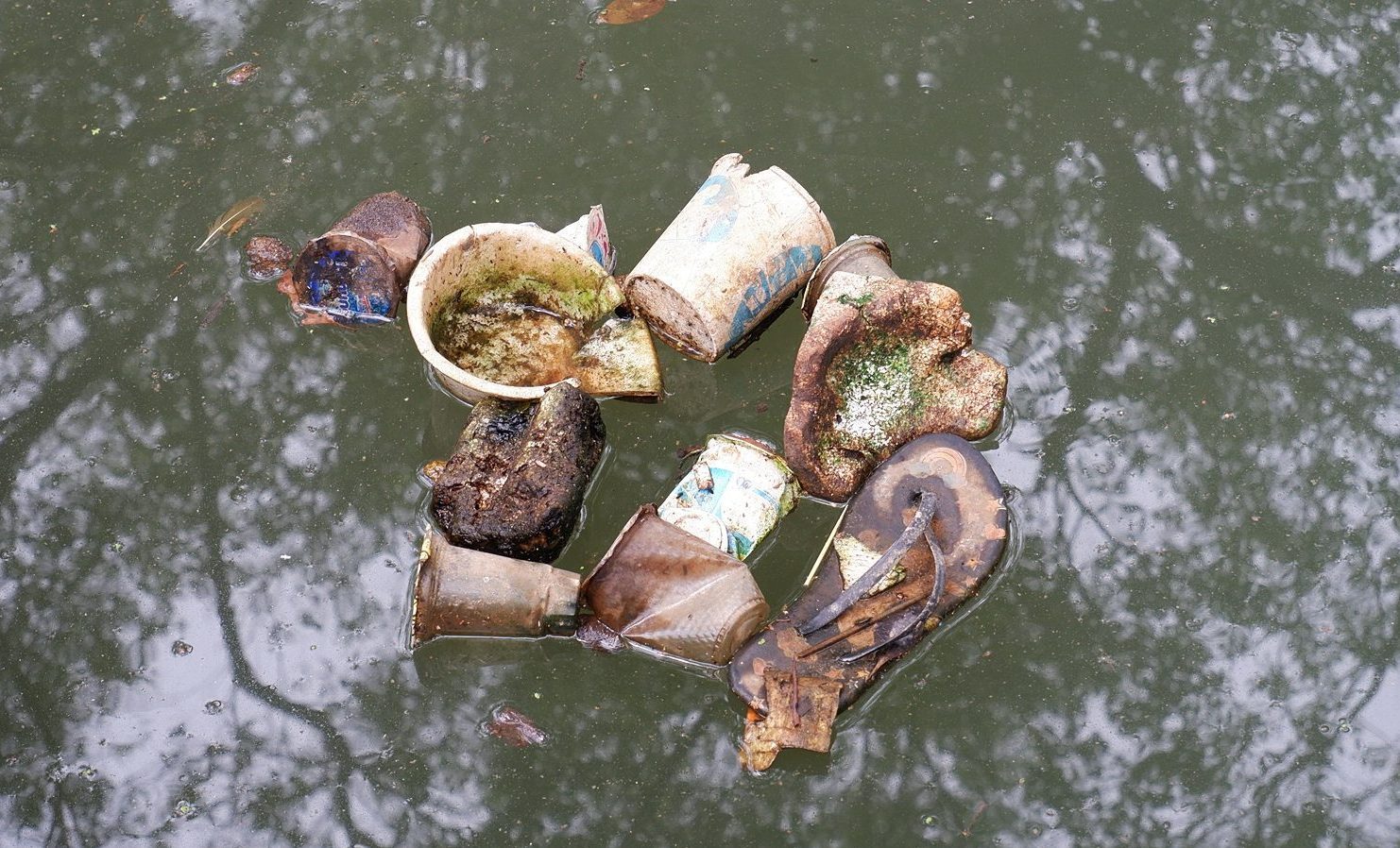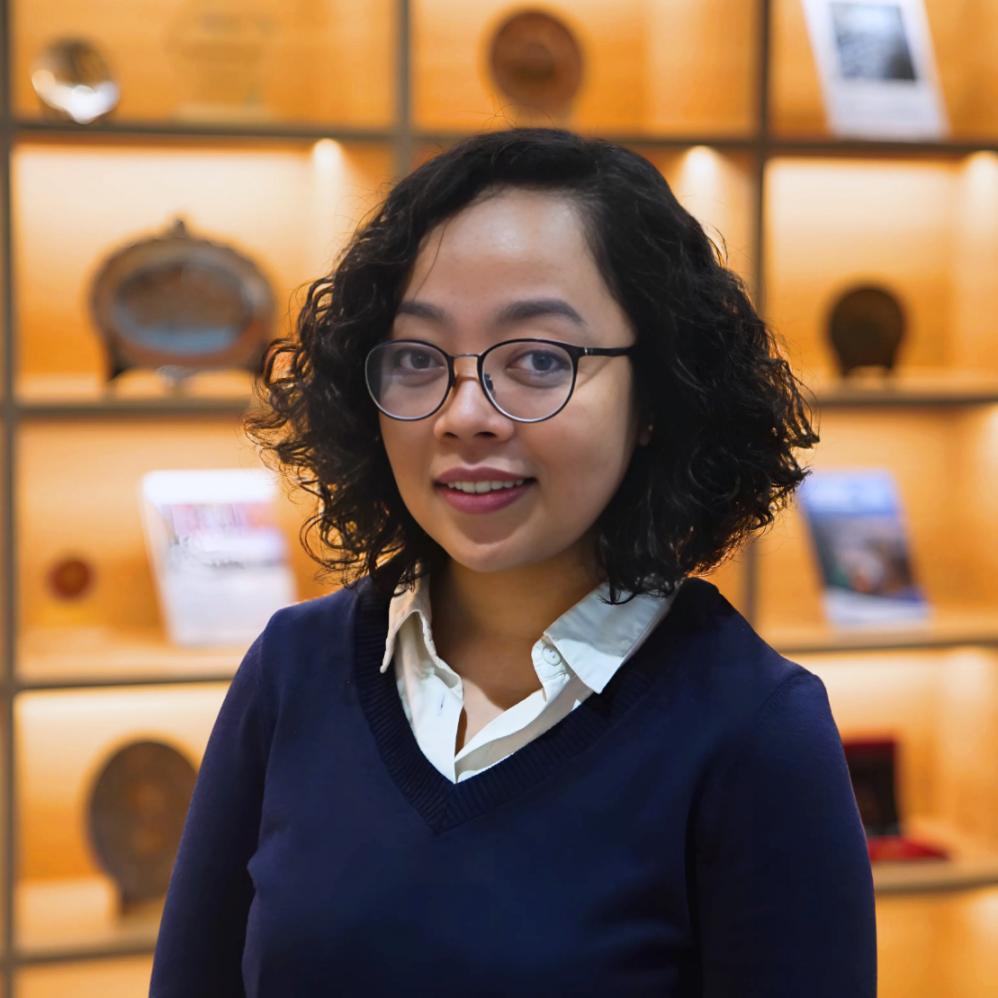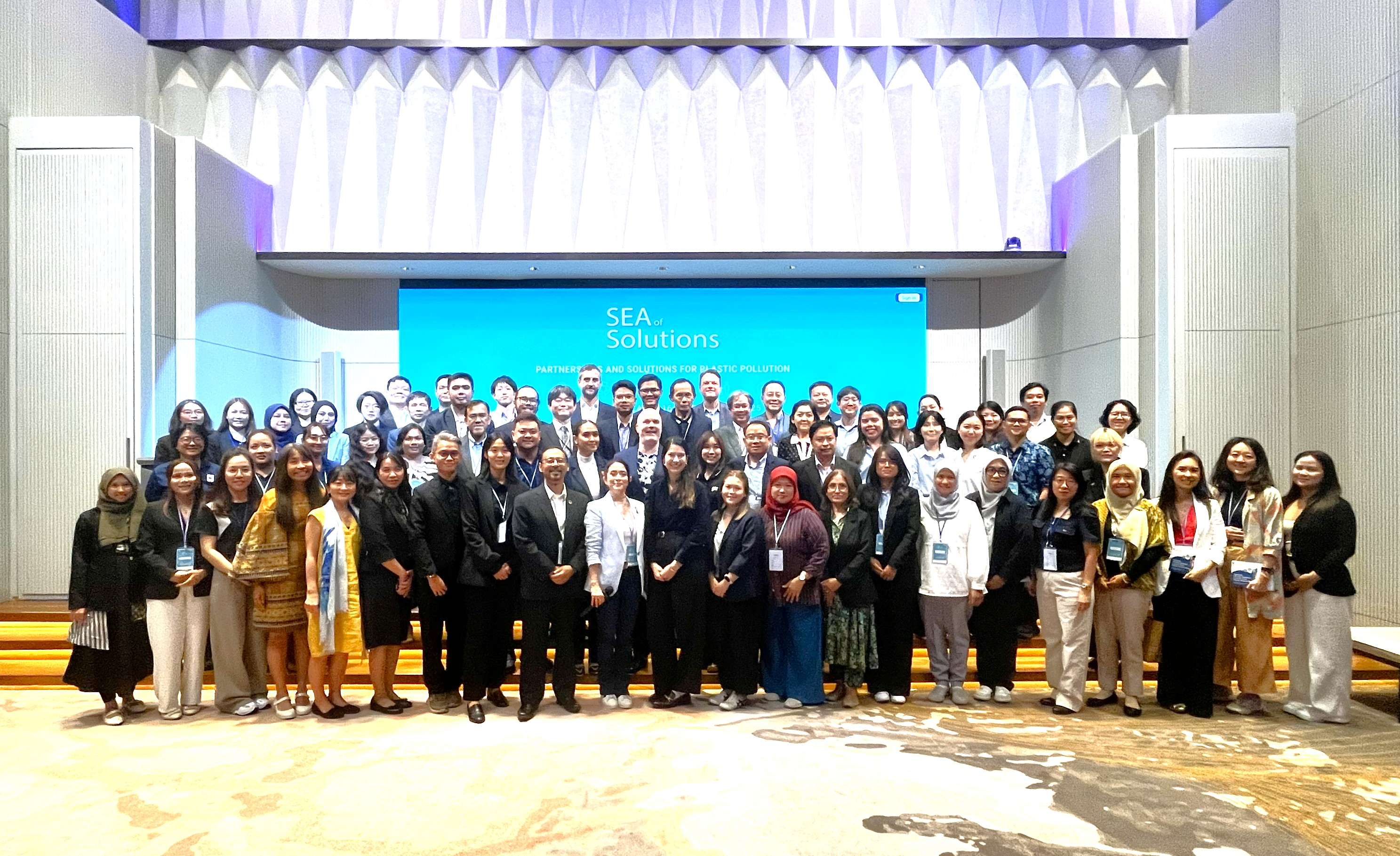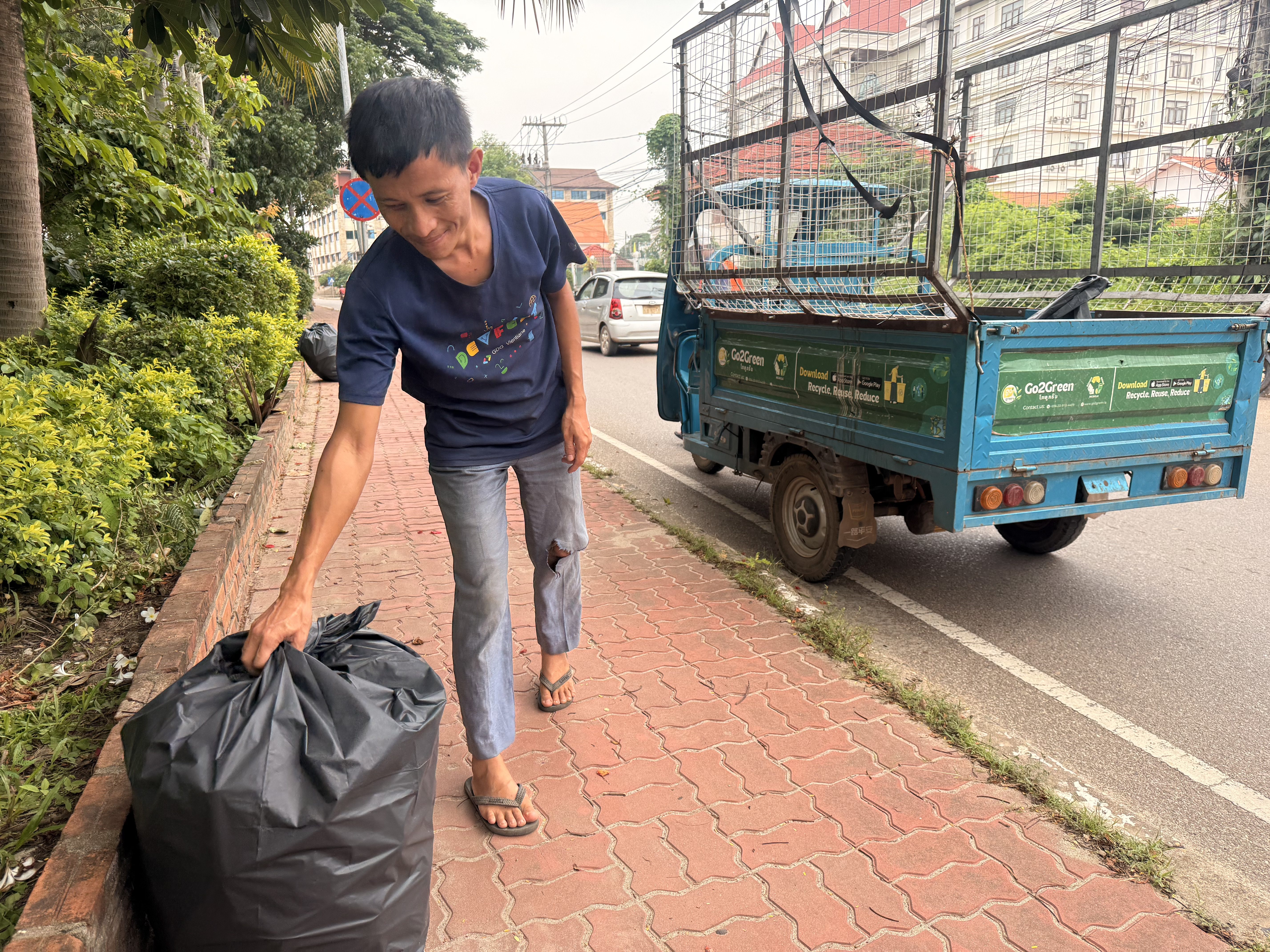

9 November 2022: A group of experts on marine plastic debris working in ASEAN+3 region visited the Jakarta Bay area to observe plastic pollution affecting the mangrove forest as well as to visit The Ocean Cleanup’s Interceptor 001 in Cengkareng Drain; the operation of a river cleanup system. The visit was part of the 3rd Meeting of ERIA’s Experts Working Group on Marine Plastic Debris held on 8-9 November 2022 in Jakarta, Indonesia.
The event, which was organized under a close collaboration between the Regional Knowledge Centre for Marine Plastic Debris (RKC-MPD) of Economic Research Institute for ASEAN and East Asia (ERIA) and the Institute for Global Environmental Strategies (IGES), aimed to bring together researchers and experts from a diverse set of disciplines to assess the region’s marine plastic pollution and gather available knowledge and data to formulate policy-relevant recommendations.
Firstly, the experts’ group visited the Mangrove Eco-Tourism Centre Pantai Indah Kapuk, located in Penjaringan, North Jakarta. The 99.82 Ha Eco Tourism Centre is a conservation area which also operates as a tourism and recreational destination managed by PT Murindra Karya Lestari as the business license holder and Natural Resources Conservation Center of DKI Jakarta Province which operates under the supervision of the Ministry of Environment and Forestry.
The Mangrove Eco-Tourism area is maintained relatively clean since the marine plastics have been intercepted in the settlement area nearby. According to Mr Rifaldi Saputra, a mangrove forest ranger who guided us throughout the visit, the plastic waste seen in the area was mainly brought by the visitors. The management of the tourism centre recorded the number of visitors reaches 750 people during the weekend (Kompas.com, 2022).
In this first destination, ERIA’s Experts Working Group donated 30 mangrove seeds to be planted in the conservation area as a symbolic contribution to the restoration of this endangered species.
Then the experts group moved on to Angke Kapuk Protected Forest. In this area, the experts had the opportunity to take a closer look at a more serious level of plastic pollution affecting the mangrove ecosystem. Located not far from the first destination, the 44.76 Ha forest is home to 15 types of mangroves and 28 species of birds (Mongabay.com, 2021) and, unfortunately, a huge amount of plastic debris.
‘During the high tide, the waves carry plastic debris from the sea to this mangrove area and then the debris gets stuck among the mangrove trees, forming a new layer of ground dominated by plastic debris once the seawater recedes’, said Mr Rifaldi.
When asked about the bamboo “interceptor” fence which was planted around the mangrove area, Mr Saputra explained that the fence was meant to prevent marine debris from polluting the mangrove.
‘It is supposed to protect the mangrove from marine plastic debris. Unfortunately, the debris still enter the area during high tide. We cannot make the fence higher because it is not very sturdy. The strong wind will bring it down if it is too high. It also gets rotten on the base quickly,’ he said.
The last destination was the Interceptor 001; a prototype of the river cleanup system initiated by The Ocean Cleanup which was deployed in Cengkareng Drain. Located less than 10 minute’s drive from the protected forest, the interceptor reduces up to 8 tons of trash per month. With two operators taking shifts alternately, this prototype has successfully cleaned the drain from more than 300 tons of plastic waste since its first operation in May 2019.
While the prototype of the interceptor continues to prevent plastic waste from leaking into the ocean from the Jakarta Bay area, the latest version of this technology has been installed in Ballona Creek, Los Angeles County, the United States. Interceptor 007, as it is called, has prevented around 16 tons of plastic debris from entering the ocean since its operation started on 6 October 2022.
‘The same technology is expected to be deployed in a dozen other rivers across Indonesia in the near future,’ said Mr Ridho Satria who represented the Royal HaskoningDHV, an engineering consultancy firm that partnered with The Ocean Cleanup.
According to their explanation, unfortunately, the collected waste is not yet analysed to assess the proportion of plastic waste and its source. But during the rainy season, the volume of the waste collected by the interceptor increases exponentially due to runoff waste finding its way into the waterways, explained the operational team of Interceptor 001.
Following the site visit, ERIA’s Expert Working Group members continued the discussion on ways to enrich the scientific data and build a firm understanding of marine plastic debris and its impact, which will be fundamental in establishing effective regional policies. All members confirmed their willingness to contribute to the collective efforts of the working group, and joint forces to work in synergy with one another’s research in order to address marine plastic pollution in ASEAN+3 region.
9 November 2022: A group of experts on marine plastic debris working in ASEAN+3 region visited the Jakarta Bay area to observe plastic pollution affecting the mangrove forest as well as to visit The Ocean Cleanup’s Interceptor 001 in Cengkareng Drain; the operation of a river cleanup system. The visit was part of the 3rd Meeting of ERIA’s Experts Working Group on Marine Plastic Debris held on 8-9 November 2022 in Jakarta, Indonesia.
The event, which was organized under a close collaboration between the Regional Knowledge Centre for Marine Plastic Debris (RKC-MPD) of Economic Research Institute for ASEAN and East Asia (ERIA) and the Institute for Global Environmental Strategies (IGES), aimed to bring together researchers and experts from a diverse set of disciplines to assess the region’s marine plastic pollution and gather available knowledge and data to formulate policy-relevant recommendations.
Firstly, the experts’ group visited the Mangrove Eco-Tourism Centre Pantai Indah Kapuk, located in Penjaringan, North Jakarta. The 99.82 Ha Eco Tourism Centre is a conservation area which also operates as a tourism and recreational destination managed by PT Murindra Karya Lestari as the business license holder and Natural Resources Conservation Center of DKI Jakarta Province which operates under the supervision of the Ministry of Environment and Forestry.
The Mangrove Eco-Tourism area is maintained relatively clean since the marine plastics have been intercepted in the settlement area nearby. According to Mr Rifaldi Saputra, a mangrove forest ranger who guided us throughout the visit, the plastic waste seen in the area was mainly brought by the visitors. The management of the tourism centre recorded the number of visitors reaches 750 people during the weekend (Kompas.com, 2022).
In this first destination, ERIA’s Experts Working Group donated 30 mangrove seeds to be planted in the conservation area as a symbolic contribution to the restoration of this endangered species.
Then the experts group moved on to Angke Kapuk Protected Forest. In this area, the experts had the opportunity to take a closer look at a more serious level of plastic pollution affecting the mangrove ecosystem. Located not far from the first destination, the 44.76 Ha forest is home to 15 types of mangroves and 28 species of birds (Mongabay.com, 2021) and, unfortunately, a huge amount of plastic debris.
‘During the high tide, the waves carry plastic debris from the sea to this mangrove area and then the debris gets stuck among the mangrove trees, forming a new layer of ground dominated by plastic debris once the seawater recedes’, said Mr Rifaldi.
When asked about the bamboo “interceptor” fence which was planted around the mangrove area, Mr Saputra explained that the fence was meant to prevent marine debris from polluting the mangrove.
‘It is supposed to protect the mangrove from marine plastic debris. Unfortunately, the debris still enter the area during high tide. We cannot make the fence higher because it is not very sturdy. The strong wind will bring it down if it is too high. It also gets rotten on the base quickly,’ he said.
The last destination was the Interceptor 001; a prototype of the river cleanup system initiated by The Ocean Cleanup which was deployed in Cengkareng Drain. Located less than 10 minute’s drive from the protected forest, the interceptor reduces up to 8 tons of trash per month. With two operators taking shifts alternately, this prototype has successfully cleaned the drain from more than 300 tons of plastic waste since its first operation in May 2019.
While the prototype of the interceptor continues to prevent plastic waste from leaking into the ocean from the Jakarta Bay area, the latest version of this technology has been installed in Ballona Creek, Los Angeles County, the United States. Interceptor 007, as it is called, has prevented around 16 tons of plastic debris from entering the ocean since its operation started on 6 October 2022.
‘The same technology is expected to be deployed in a dozen other rivers across Indonesia in the near future,’ said Mr Ridho Satria who represented the Royal HaskoningDHV, an engineering consultancy firm that partnered with The Ocean Cleanup.
According to their explanation, unfortunately, the collected waste is not yet analysed to assess the proportion of plastic waste and its source. But during the rainy season, the volume of the waste collected by the interceptor increases exponentially due to runoff waste finding its way into the waterways, explained the operational team of Interceptor 001.
Following the site visit, ERIA’s Expert Working Group members continued the discussion on ways to enrich the scientific data and build a firm understanding of marine plastic debris and its impact, which will be fundamental in establishing effective regional policies. All members confirmed their willingness to contribute to the collective efforts of the working group, and joint forces to work in synergy with one another’s research in order to address marine plastic pollution in ASEAN+3 region.

Knowledge Management Associate



